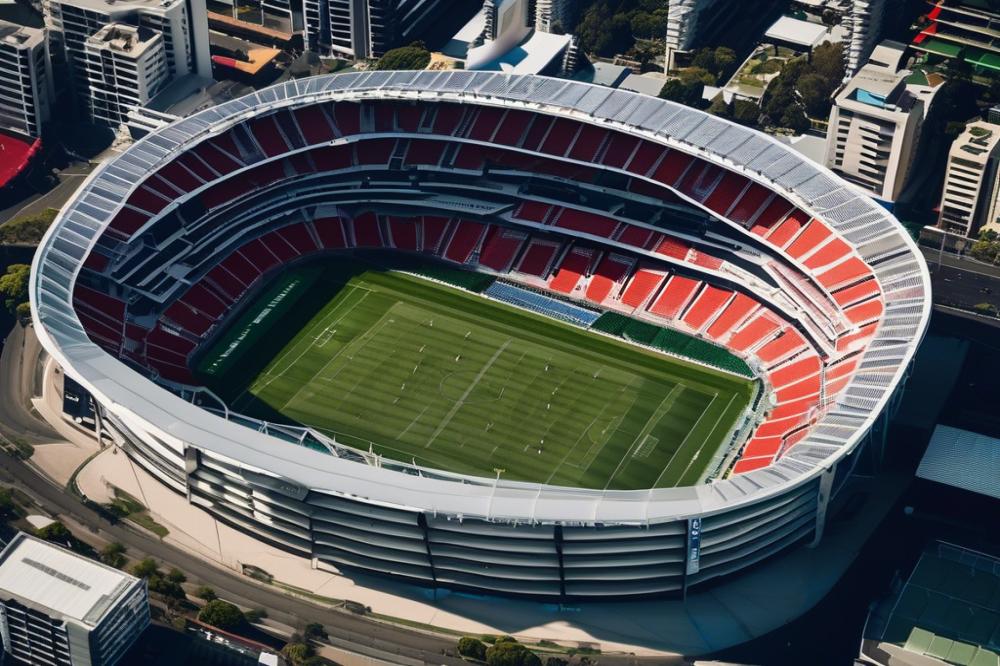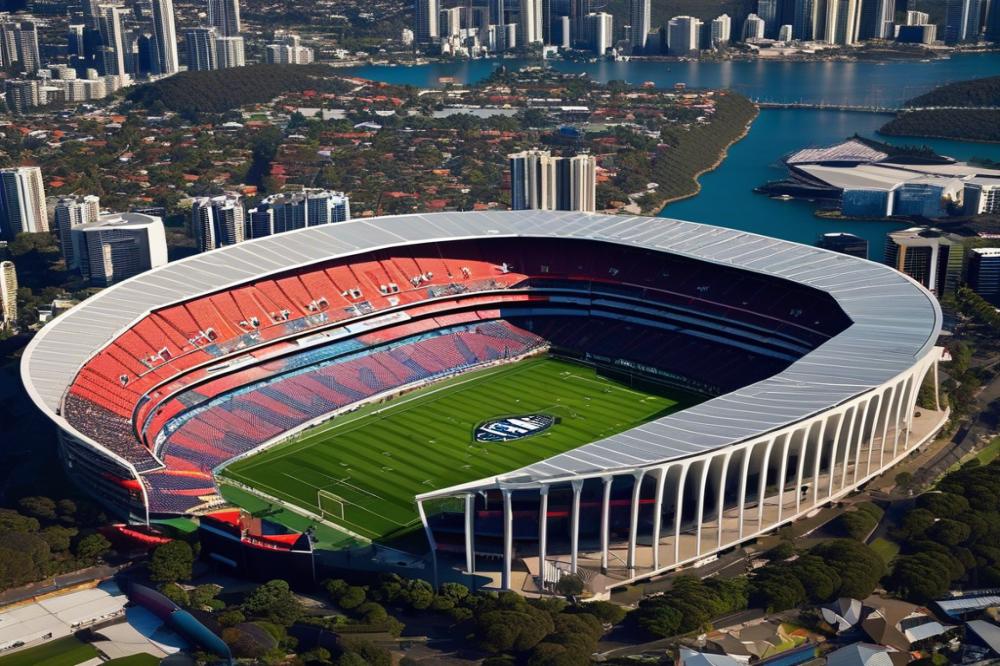The Impact of Stadium Relocations on NRL Clubs
In recent years, rugby league has experienced notable transformations, prominently through shifts in stadium venues. These changes mark a pivotal period for the National rugby league (NRL). Understanding the current landscape requires a deep dive into what drives these relocations and the effects they produce.
NRL stadium relocations have far-reaching implications. The move from one venue to another does not merely involve logistics. It fundamentally affects club management and fan engagement. Clubs must balance the demands of their supporters while also considering the financial consequences. Stadium economics can deeply influence the decision-making processes.
Stadium changes also alter team performance. Familiarity is disrupted, which can affect player morale and results. Fans play a crucial role here. Fan loyalty might waver if clubs don’t tread carefully with their relocation strategy. Maintaining high NRL attendance becomes an intriguing challenge as the dynamics shift.
The stakes are high for stakeholders. Communities frequently feel the pinch when a local team’s venue changes. The community impact is significant, often influencing local businesses, tourism, and neighborhood identity. Sports infrastructure improvements must be measured against these community concerns.
For NRL clubs, decisions about moving venues rest upon various strategies. Evaluating the potential benefits and drawbacks for all involved parties demands precision and keen insight. This balancing act ensures that the core identity of the club and its supporters remains intact. Consequently, the impact on NRL clubs can be profound, reshaping relationships and altering the rugby league landscape.
The Dynamics of Rugby League Stadiums

Overview of Current NRL Stadiums, Location, and Capacity
Australia’s NRL stadiums are spread across major cities. Sydney hosts several clubs. Suncorp Stadium in Brisbane is a well-known venue. Its capacity? A robust 52,500. Melbourne’s AAMI Park is slightly smaller with seats for 30,050 fans. Sydney Cricket Ground, iconic for many, holds up to 48,000. These locations witness intense matches. Stadiums serve as the heart of club activities.
Importance of Sports Infrastructure in Rugby League
Sports infrastructure is crucial to rugby league’s success. Quality facilities influence NRL attendance. They offer comfort and excitement. Modern amenities attract new fans. Enhanced experiences keep existing supporters coming back. club management often focuses on infrastructure. Many teams strategize investments here. Sports infrastructure impacts team performance. Happy fans, motivated players, better outcomes. Communities also benefit economically. Local business thrives near successful stadiums.
Typical Stadium Relocation Strategy Adopted by NRL Clubs
NRL stadium relocations can transform a club. They assess their needs deeply. Fan engagement shapes decisions. Balancing community impact and economics is key. Locations are chosen meticulously. Accessibility matters. Public transport options get considered too. Club management checks potential fan loyalty shifts. They aim to minimize disruptions. Ensuring a seamless transition is vital. Teams yearn for stable support. With solid backing, they strive for new heights. Ultimately, a well-planned relocation benefits both the club and its supporters.
Economic Implications of Stadium Relocations

Role of Stadium Economics in Club Management Decisions
Stadium economics plays a vital role in rugby league club decisions. When teams decide to move, it’s not just for new seats. It’s about improving their whole situation. Management examines potential gains in revenue and how these can affect club performance. Clubs often weigh the cost of maintaining older venues against building modern sports infrastructure. New stadiums can offer increased fan engagement opportunities through enhanced facilities. They become part of a strategic plan for growth. A well-placed stadium can even attract national events, further increasing club profits.
Impact on NRL Attendance and Revenue Streams
Relocations influence NRL attendance figures significantly. Fans might travel further to watch games if the facilities are better. However, sometimes they stay away from new locations. Both scenarios impact revenue streams. Ticket sales can rise in modern facilities with better amenities. Merchandising and concessions also see boosts when more spectators attend matches. On the other hand, poor relocation strategy leads to decreased loyalty and attendance. Community impact should not be underestimated. Clubs must consider fans’ emotions and connections to old venues. Solid strategies keep loyal fans engaged and attract new supporters.
Comparison of Relocation Costs vs Potential Financial Benefits
The costs of moving are immense. Clubs face expenses like construction, marketing, and logistics. These need to be compared to possible financial benefits. New stadiums may promise long-term gains through increased capacity and comfort. But the actual expense of such moves can be staggering. Relocation costs can spiral out of control without careful planning. Yet, over time, improved facilities may result in consistent gains in revenue. Successful relocations deliver more than just improved economics. They ensure enhanced fan experiences, potentially boosting team performance. Ensuring economic success involves diligent evaluation and planning.
Community and Cultural Impact
Effects on local communities and the significance of place
Moving a rugby league club from its original stadium affects local communities in profound ways. Fans often feel a deep connection to the location. It’s not just about proximity, it’s about heritage. Imagine a small town losing its beloved team, which once brought people together every weekend. The stadium, more than a building, serves as a meeting place for connection. When such a structure relocates, the local economy suffers. Small businesses relying on game-day crowds struggle or simply vanish. Community pride can wane, creating a void hard to fill. Passionate fans lose their weekly rituals and cultural ties, dissolving bonds built over decades. The emotional connection to a place holds more weight than just physical bricks or seats.
Fan loyalty and engagement challenges during relocations
Relocating a team can test fan loyalty severely. Change is never easy, especially for devoted supporters. All of a sudden, the familiar drive to the game becomes a long trek. NRL attendance often dips when relocations are involved. Naturally, distance dampens ardor. Club management faces hard questions: How to keep fan engagement alive? It’s a real puzzle. Newer stadiums may offer better facilities, but that doesn’t replace history or memories. Marketing strategies tend to focus on families, hoping to entice all ages. Yet, nostalgia grips hardcore fans, whose attachment isn’t easily transferred. Stadium relocations force fans to build new traditions. Still, this shift can fragment once cohesive groups.
Cultural considerations and the rugby league identity
Rugby league carries a deep-seated identity intertwined with local culture. It’s more than a game; it’s a legacy. The relocation strategy must balance modern needs with these traditions. Ignoring cultural history can alienate the loyalist base. NRL clubs have long histories; these stories foster dedication. Complex though it is, cultural respect is key. Team performance can suffer if this is mismanaged. The sport’s identity leans heavily on community and roots. Building a new stadium shouldn’t erase what came before. Successful relocations involve fans from the outset, which eases transitions. Acknowledging traditional roots within new contexts honors legacy. Balancing stadium economics with cultural elements requires tactful club management and forward-thinking strategies.
Impact on Team Performance
How moving stadiums can influence team morale and performance
Relocating to a new stadium can be a game-changer for rugby league clubs. The shift often affects more than just logistics. It involves team morale. Players get used to specific settings—above all, a familiar home ground. The atmosphere of the original stadium becomes part of their home advantage. With movement to a new venue, this familiarity is disrupted, impacting their confidence and performance.
Club management must address these changes head-on. New locations can either inspire or dishearten a squad. The bond they share with their familiar stadium shifts, often altering the dynamics of the team itself. Psychologically, regular travel to an unfamiliar place can impact performance. It’s not just about winning games. Emotional ties matter.
Statistics on performance changes post-relocation
Statistics reveal a mixed bag of results following stadium relocations. Some teams notice a decline in early momentum. Various clubs show a decrease in win rates immediately post-relocation. For example, an NRL team going from a 65% win rate to 50% after a stadium relocation isn’t uncommon. Yet, a few eventually adjust and improve over time. Despite an initial slump, some clubs return to their previous performance levels.
NRL attendance figures often reflect similar trends. Attendance usually dips initially as fans adjust to the new venue. Fan loyalty faces tests as supporters weigh their devotion against the convenience of attending games. Once adaptation takes place, attendance figures can recover, sometimes even surpassing former levels.
Insights into club adaptation strategies
Adaptation strategies are crucial. Successful clubs use deliberate action plans. A strong relocation strategy ensures smoother transitions. Clubs often engage players early in the process. This engagement boosts morale and reinforces commitment. Managers can organize tours of the new venue for players before the big move.
Fan engagement is another critical area. By involving supporters in decision-making processes, clubs can strengthen community impact. Open days, meet-and-greets, and special ticket deals can be effective. Merchandise strategies may also help ease the transition.
Adapting to new sports infrastructure can also necessitate changes in training routines. Teams might need to adjust practice schedules in line with new stadium availability. Training in the new environment early helps adjust to the new field conditions and dimensions. When effectively managed, these tactics minimize disruption. Stadium economics and fan engagement become focal points. The ultimate goal is to make the new venue feel like home.
In summary, navigating stadium moves is a multifaceted challenge. Club management must juggle numerous factors, from adapting training to managing fan relationships. If handled well, the disruption can pave the way for renewed success.
Fan Engagement and Loyalty
Addressing Concerns and Maintaining Fan Loyalty During Relocations
When a rugby league club undergoes stadium relocations, fan loyalty can be seriously tested. Supporters are deeply connected to their team’s home ground and view it as sacred. It’s essential for club management to acknowledge these sentiments. They must communicate openly, explaining the reasons for relocation. Fans want to feel involved in the process. Sharing plans and seeking input can maintain a sense of belonging. It’s all about participation. Many fear that relocating affects tradition and the home atmosphere they cherish.
Club management can ease these fears by preserving traditions. Retaining familiar elements, like team colors and memorabilia, is crucial. Encourage fans to express their concerns and incorporate their feedback. The community impact of moving to a new stadium should be considered as well. A relocation strategy that involves fans can foster acceptance.
Strategies to Enhance Fan Engagement Through New Stadium Experiences
Utilizing the new stadium provides an incredible opportunity. Clubs can create innovative experiences that surpass the old ones. Modern sports infrastructure offers advanced facilities. Enhanced seating comfort, better sightlines, and improved amenities make attending games more enjoyable. Introducing unique fan zones and interactive activities boosts engagement.
Enhancing NRL attendance figures can result from favorable changes. Special events around the stadium, exclusive access to team interactions, and community programs matter greatly. It’s vital to forge emotional connections beyond just the matches. Stadium economics can also play a role in fan engagement, as better facilities can make ticket prices more justifiable through improved experiences.
Case Studies of Successful and Unsuccessful Engagement Efforts
In some cases, clubs have achieved remarkable success with relocations. Case studies like those from the past demonstrate this. Maintaining fan engagement was paramount. A well-executed strategy can strengthen relationships. For instance, one club scheduled numerous fan events, increasing commitment to the new location.
Not all efforts succeed, however. A few relocation attempts failed to consider fan sentiments. Some neglected the atmosphere fans considered essential. In these instances, attendance often dropped. Lessons from these attempts highlight the necessity of advanced planning. Understanding what fans value can guide efforts rightfully.
Ultimately, keeping fans engaged requires thoughtful approaches. From the right communication strategies to involving fans in decision-making, the journey to a new stadium can indeed maintain, or even grow, enthusiasm and loyalty.
Impacts and Future of Stadium Relocations
Stadium relocations in the NRL present a complex array of consequences. Economic, social, and performance aspects all intertwine, affecting clubs in diverse ways. Financial gains and state-of-the-art facilities can tempt club management. However, fans often feel torn between excitement and nostalgia.
Looking ahead, clubs facing relocation decisions must tread carefully. Balancing economics against the community’s attachment is crucial. The future may hold more shifts, driven by financial incentives and the promise of growth in rugby league. Nevertheless, clubs must weigh these benefits against potential disruptions to local fan bases.
Balancing interests requires careful consideration. Economic viability, community support, and player performance all demand attention. Ultimately, success hinges on finding harmony between these elements. A singular focus on profit or prestige might alienate loyal fans. Clubs need to foster environments that encourage both community spirit and athletic excellence.



